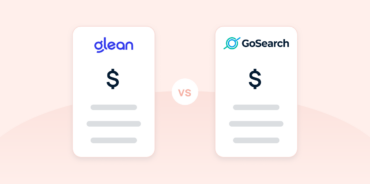The ability to find relevant information quickly can mean the difference between an efficient, productive day and hours wasted searching through documents, apps, and emails. This is where AI querying best practices come into play.
For many organizations, enterprise search tools like GoSearch have become indispensable. But to truly unlock the potential of these tools, understanding how to craft good queries is essential.
Whether you’re searching for a customer’s recent purchase history, team updates, or insights from the latest sales report, well-optimized queries can help you get the results you need faster and more accurately.
Let’s explore why effective querying matters, what GoSearch brings to the table, and how to improve your search practices.
What is GoSearch?
GoSearch is an AI-driven enterprise search tool designed to streamline access to workplace information. By connecting securely to your organization’s apps, databases, and cloud platforms, GoSearch helps you find exactly what you need.
For example, instead of manually sifting through email threads or project management tools to find a status update, GoSearch processes your query and delivers the most relevant and actionable results in seconds.
It’s more than just a search bar—GoSearch transforms the way you work by giving you quick, reliable access to your company’s collective knowledge.
How GoSearch works:
GoSearch integrates seamlessly with your workplace apps, including cloud storage, CRM systems, project management tools, and communication platforms like Slack or Teams. Once connected, it scans and organizes data from these sources. When you type in a query, GoSearch’s AI-driven algorithms go to work, analyzing millions of data points to surface the most relevant results.
GoSearch incorporates AI-powered features such as multimodal search and custom GPTs to provide an enhanced search experience. It surfaces links, relevant documents, AI-generated summaries, and even visual or chat-based results to streamline your workflow.
How to optimize your GoSearch queries
Thanks to AI and natural language processing, GoSearch is ready to interpret any query you give it. But to make the most of GoSearch, we put together some steps you can take to optimize your search queries.
Let’s dive into what makes a query effective and how you can refine your searches for better results.
1. Figure out your objective:
Before typing a query, consider your end goal. Are you searching for a specific document, a link to a project, or a data summary? Being clear about your objective will guide how you frame your search query and will help GoSearch surface the most relevant information.
For instance, if you need the latest customer sales report, think about whether you’re looking for a detailed document, a dashboard link, or a quick AI-generated summary of key insights.
2. Be specific:
A good query is precise and goal-oriented. While GoSearch can handle vague queries, being specific could improve the accuracy of the results. For example, searching “customer purchase history” might surface hundreds of files, but searching “customer purchase history Q2 2025” will significantly narrow the results.
3. Specify a desired format:
Sometimes the same information exists in multiple formats—spreadsheets, slide decks, or PDFs. If you’re looking for a specific format, include it in your query. For instance, if you’re searching for the 2025 marketing plan, and you know it’s in a slide format, include that in the query (e.g., “2025 marketing plan slide”).
4. Use filters:
GoSearch offers a range of filters to narrow down your search results. Filters include file type, task, owner, modified date, and more. For example, let’s say you’re searching for a report updated last week. By using the modified date filter, you can limit results to documents from the past seven days, streamlining your query to the most recent and relevant documents.
5. Use multimodal AI:
GoSearch’s multimodal search allows you to search using not just text but also images and links. For instance, if you’re looking for visual assets like logos or infographics, you can search directly with images, making the process faster and more intuitive.
This multimodal approach can also help improve your querying results when you’re working with data tables or visual reports that are hard to describe in words. Simply drop a relevant image into the search bar, and GoSearch will take care of the rest.

6. Have a conversation with GoAI chat:
For complex queries or when you need more in-depth answers, GoSearch offers an AI workplace assistant. This feature allows you to have a back-and-forth conversation with the AI to refine your results or gain insights. It is particularly useful for content creation, data analysis, or understanding complex reports.
For instance, you might ask GoAI to help you write SQL queries or explain the sorting order of specific data. You can guide the AI to provide structured, actionable insights by breaking down complex prompts into smaller steps.
Tips for using GoAI chat:
- Break complex tasks into smaller steps to get clearer responses.
- Use bullet points to highlight key questions or prompts for better AI comprehension.
- Provide feedback to GoAI using the thumbs-up/thumbs-down feature, helping it refine future responses.

7. Test and refine:
Finally, don’t hesitate to test and refine your queries to improve query performance and accuracy. Start by entering a simple prompt and reviewing the results. If necessary, adjust the phrasing or add more specific keywords to improve accuracy.
GoSearch allows you to provide feedback on results, which helps the AI improve over time. This continuous refinement will help tailor GoSearch to your specific needs, making it an even more powerful tool in your daily workflow.
Getting started with GoSearch
Ready to improve your querying experience? Start by integrating GoSearch into your daily workflow. Whether you’re retrieving data from CRM systems, project management tools, or cloud-based platforms, GoSearch will help you find the information you need faster and more efficiently. To learn how GoSearch can transform how your team accesses and uses critical information, join our on-demand demo.
Search across all your apps for instant AI answers with GoSearch
Schedule a demo

















